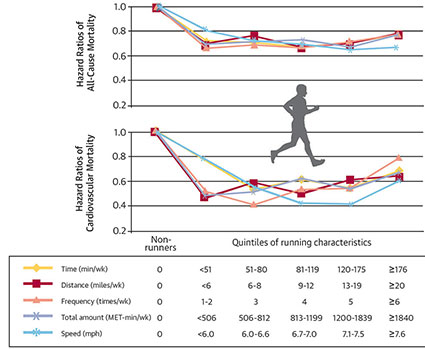Physical Activity Epidemiology Lab
Location: Room 189 Forker
Coordinated by professor Duck-Chul Lee (DC Lee)
The Physical Activity Epidemiology Lab conducts human research on the effects of lifestyle physical activity, sedentary behavior, resistance and aerobic exercise training, cardiorespiratory fitness, and muscular strength, on various health outcomes such as hypertension, diabetes, obesity, cancer, sarcopenia, and cardiovascular disease morbidity and mortality in adults and older adults. Methodologically, this research involves a comprehensive epidemiological approach that includes both large observational (cohort) studies and randomized controlled trials of exercise.
Research Topics
Big Data Analyses on Physical Activity and Chronic Disease Prevention and Longevity
ISU Research on the Benefits of Running
Our lab investigates the effects of physical activity on the development of chronic diseases and mortality using a large prospective cohort studies such as the Aerobics Center Longitudinal Study (ACLS) in over 80,000 men and women with 35 years of follow-up. We have published over 50 papers using several big cohort data, and one paper published in JACC in 2014 on leisure-time running and mortality has been featured in over 350 major media outlets around the world including US national TV (‘NBC’ & ‘ABC’), and magazines including ‘The New York Times,’ ‘CNN,’ and ‘The Washington Post’. Currently, we are working on over 20 research projects using several national and international big cohort data including the ACLS, PAAS, and UK Biobank. These studies will have direct impact on the development of public health policy and guidelines (e.g., US and WHO Physical Activity Guidelines).
Longitudinal Cohort Studies on Physical Activity and Health in Older Adults
In 2015 our lab launched a prospective cohort study called, “Physical Activity and Aging Study (PAAS)” to investigate the long-term associations of physical activity with the development of chronic diseases (e.g., heart diseases, cancer, diabetes, etc.), healthy aging, and longevity in older adults through their lifespan. We assess comprehensive health and fitness measures including full body bone mineral density and body composition using DXA scan, body shape, posture, and balance using Fit3D, cardiovascular function (arterial stiffness and central blood pressure) using SphygmoCor device, lung function using spirometer, blood lipids and glucose profiles, sleep quality and quantity, cognition, mental health, dementia screening, physical fitness (muscular strength and cardiorespiratory fitness), several functional ability tests (400 meter walk test, SPPB, get-up test, etc.), and comprehensive physical activity using Fitbit, accelerometer, heart rate monitor, pedometer, and detailed survey tools. Since 2015 we have been conducting the health assessments for over 700 older adults, and they participate in annual follow-up health assessments each year. We plan to continue to follow the current participants and add new participants each year as a longitudinal cohort study. This study will add important evidence to develop guidelines about the optimal amount, intensity, and types of physical activity to prevent, delay, and treat chronic diseases and increase independence and longevity in diverse older adult populations. In 2013 we conducted another observational study to examine muscle-strengthening activities (e.g., weight lifting and carrying heavy loads) in daily life on cardiovascular disease risk factors (e.g., blood pressure, waist circumference, etc.) in over 450 middle-aged or older adults.
Randomized Controlled Trials of Exercise Training on Chronic Disease Risk Factors
One of our specific research interests in the lab is to investigate the health benefits of resistance exercise such as weight lifting independent of and combined with aerobic exercise. The current Physical Activity Guidelines have primarily focused on aerobic exercise for health benefits, but little is known about the health effects of resistance exercise. To conduct exercise intervention studies, we established a Technogym Wellness System, a computer-based automatic exercise monitoring system in the lab. Using this innovative system, we conduct randomized controlled trials of resistance and aerobic exercise. Currently, we are conducting a 1-year long exercise trial in 400 hypertensive and overweight/obese adults, which was funded by NIH. This study was designed to compare the relative contribution of aerobic and resistance exercise to hemodynamics and arterial stiffness, glucose metabolism, blood lipids profiles, body composition, inflammatory markers, and other established and emerging cardiovascular disease risk factors.
Current Research Projects
Comparison of the Cardiovascular Benefits of Resistance, Aerobic, and Combined Exercise (Cardio-RACE)
Principal Investigator: Lee, DC.
Source: NIH (NHLBI) R01 (1R01HL133069-01) (July 2016 – April 2022).
This research is to investigate the comparative effectiveness of the cardiovascular benefits of resistance, aerobic, and a combined exercise by conducting 1) a large cohort data analysis using the Aerobics Center Longitudinal Study and 2) a 1-year randomized controlled trial of exercise in 400 adults who are at high risk of developing cardiovascular diseases.
Physical Activity and Aging Study (PAAS)
Principal Investigator: Lee, DC.
Source: Internal Research Fund (2015~)
The original research was to investigate the associations of physical activity and fitness with sarcopenia in 300 older adults by conducting a 1-year prospective observational study in 2015. Since then, we have followed the original 300 participants and continued to recruit new participants to establish a longitudinal cohort study called, “Physical Activity and Aging Study (PAAS)” to investigate the health benefits of physical activity on chronic disease prevention, healthy aging, and longevity. Visit research site.
Lab Equipment
Technogym Wellness System including a total of 25 exercise equipment (13 aerobic and 12 resistance exercise equipment), full-body DXA scanner, SphygmoCor devices to measure central hemodynamics (aortic stiffness and central blood pressure), spirometer to measure lung function, Fit3D body shape and image analyzer, InBody 720 body composition analyzer, 24-hour heart rate monitors, over 300 accelerators and pedometers, Fitbit activity monitors, and many more health and fitness equipment.
Research Team
There are 8-10 senior research staff members (post-doctoral fellows, full-time research associates, and graduate students) and around 50-100 undergraduate research assistants in the lab working on human research projects including observational and intervention studies.
We are currently recruiting graduate students (master and PhD). If you are interested, please email Dr. Lee.
Need More Information?
Duck-Chul Lee
103h Forker Building
534 Wallace Road
Ames, IA 50011-4008
